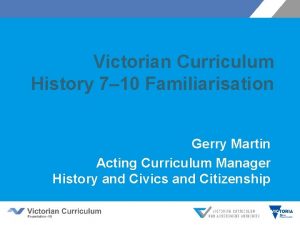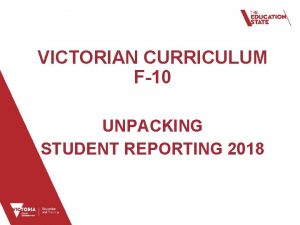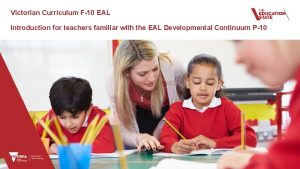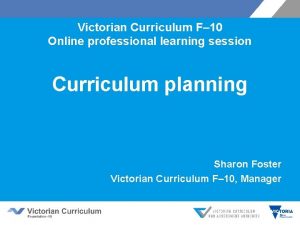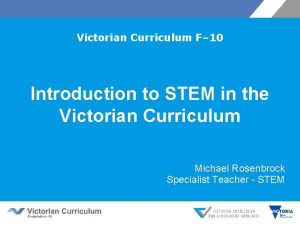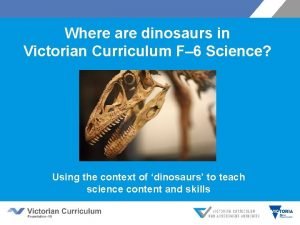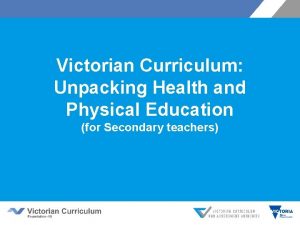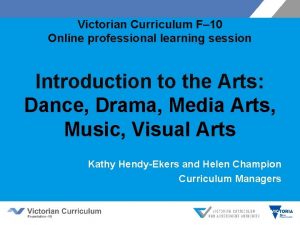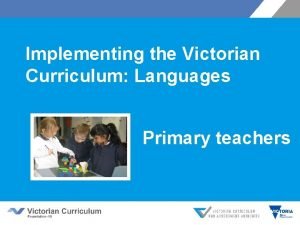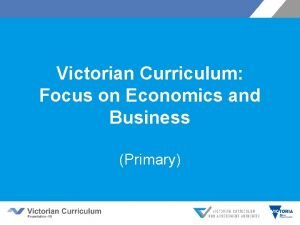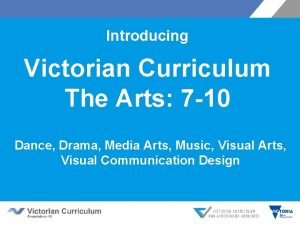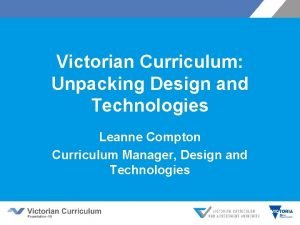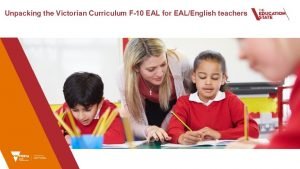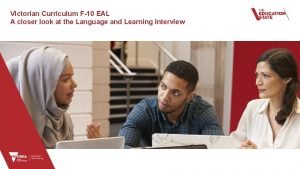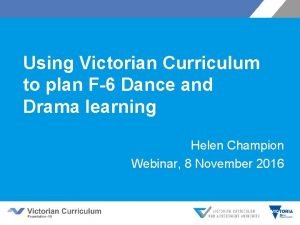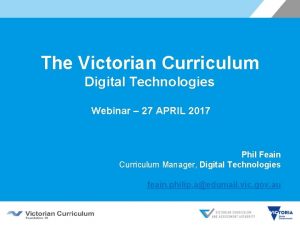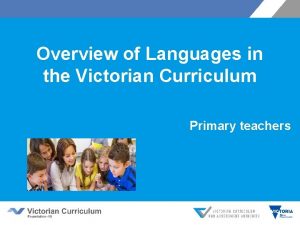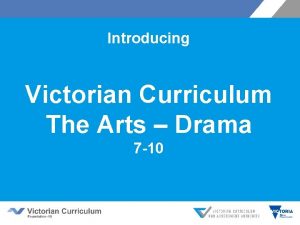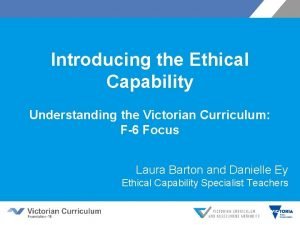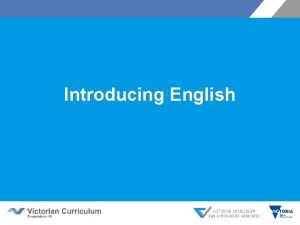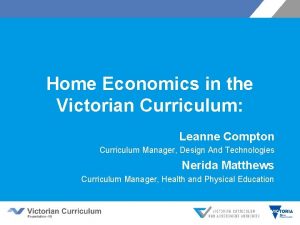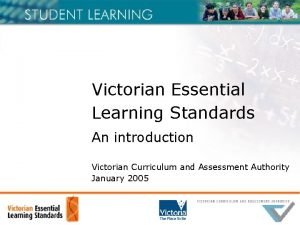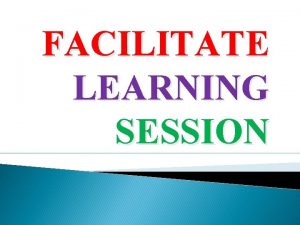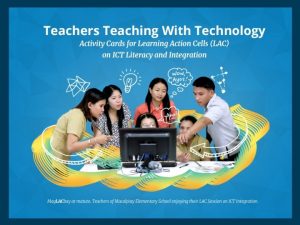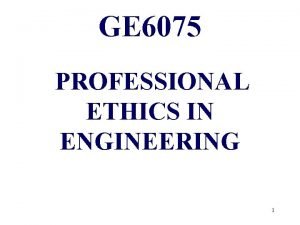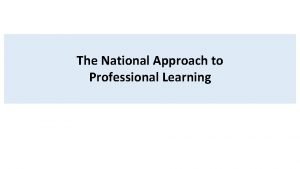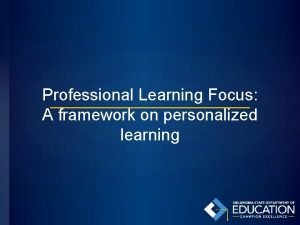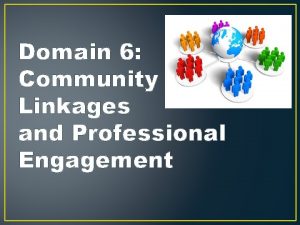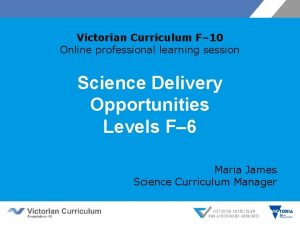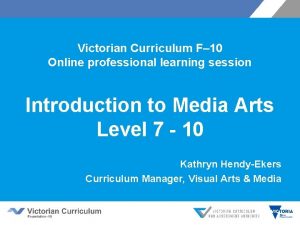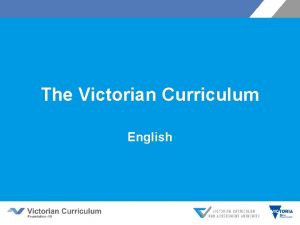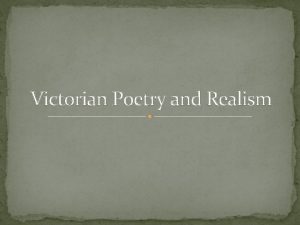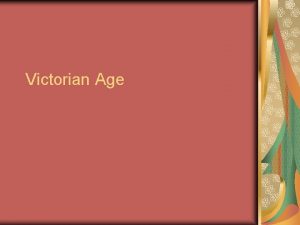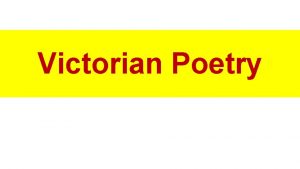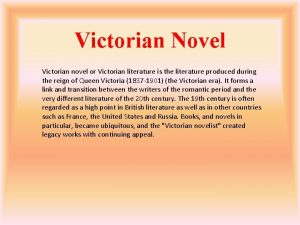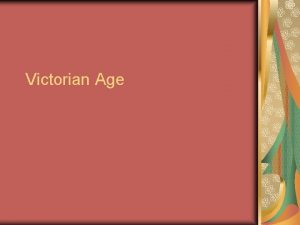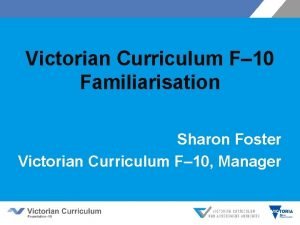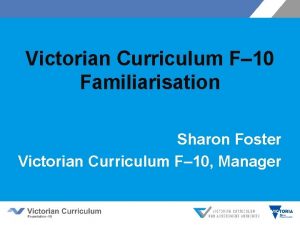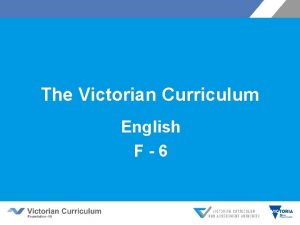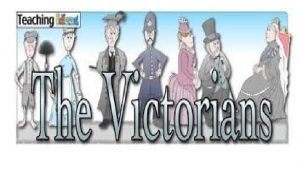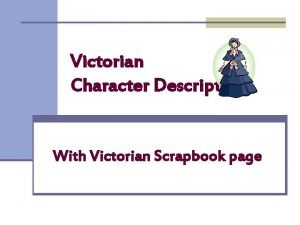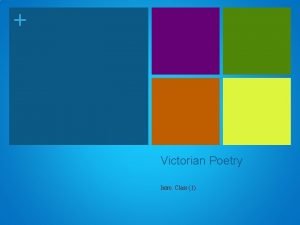Victorian Curriculum F 10 Online professional learning session






































- Slides: 38

Victorian Curriculum F– 10 Online professional learning session Specialist delivery of Dance, Drama and Music Helen Champion Curriculum Manager

Session overview • • The Arts in the Victorian Curriculum • Learning area structure • Organising ideas • Working with interdependent strands • Using the web site Curriculum planning for Arts learning • Whole school, learning area, year, units/sequences of learning • Roles for generalist and specialist teachers • Partnerships, incursions, excursions and residencies What’s in the curriculum? Dance, Drama, Media Arts, Music and Visual Arts Choosing resources

Victorian Curriculum F– 10 • Released in September 2015 as a central component of the Education State • Provides a stable foundation for the development and implementation of whole-school teaching and learning programs • The Victorian Curriculum F– 10 incorporates the Australian Curriculum and reflects Victorian priorities and standards http: //victoriancurriculum. vcaa. vic. edu. au/

Learning areas & Capabilities Learning Areas Victorian Curriculum F-10 is represented as a continuum of learning The Arts • Dance • Drama • Media Arts • Music • Visual Arts • Visual Communication Design English Health and Physical Education The Humanities • History • Geography • Civics and Citizenship • Business and Economics Languages Mathematics Science Technologies • Design and Technologies • Digital Technologies Capabilities Critical and Creative Thinking Ethical Intercultural Personal and Social

The Arts in the Victorian Curriculum 1 Learning Area with curriculum for six Arts disciplines: F-10 • Dance, • Drama, • Media Arts, • Music, • Visual Arts 7 -10 • Visual Communication Design

Victorian Curriculum: The Arts 4 +2 Strands: • • explore & express/represent ideas practices present & perform respond & interpret Organising ideas: • students learn as artist and as audience • Students learn by making & responding

Levels of achievement F 1 -2 3 -4 5 -6 7 -8 9 -10 • The curriculum is represented on a continuum across 6 levels of achievement • In The Arts, an achievement standard is provided for each band • The Foundation (F) standard signifies the importance of The Arts in the early years of schooling • A curriculum to support students with a disability is provided and this is know as Towards Foundation Levels A-D

Terminology • Band/Level descriptions • statements that provide an overview to the content descriptions and achievement standard within the level or band. • Strands • key organising elements within each curriculum area. • Content descriptions • specific and discrete information identifying what teachers are expected to teach and students are expected to learn. • Elaborations • non-mandated, advisory examples that provide guidance on how the curriculum may be transformed into a classroom activity or learning opportunity. • Achievement standards • statements that describe what students are typically able to understand, and are the basis for reporting student achievement.

Common strand structure The Arts have a common structure involving four interdependent strands, each involving making and responding Explore and Express/Represent Ideas Present and Perform Practices Respond and Interpret

Strands Explore and Express/Represent Ideas Practices Present and Perform Respond and Interpret F– 6 7– 10 Exploring ideas and improvising with ways to express/represent ideas. Explore ideas and improvising with ways to express/represent ideas. Manipulating and applying the elements/concepts with intent. Developing and refining understanding of skills and techniques. Structuring and organising ideas into form. Sharing through performance, presentation or display. Analysing and reflecting upon intentions. Examining and connecting artworks in context. Developing and refining understanding of skills and techniques. Structuring and organising ideas into form. Sharing artworks through performance, presentation or display. Analysing and reflecting upon intentions. Examining and connecting artworks in context.

Learning as artist and audience Artwork Artist Audience responding and interpreting using imagination expressing/representing ideas presenting and performing techniques and processes using materials practicing skills instruments evaluation exploring thinking analysis media

Making and responding Making is informed by responding & responding informs making Students learn as artist and as audience through making and responding

Curriculum and resources Curriculum • • 2016 school choice between Aus. VELS and Victoria Curriculum F – 10 Victorian Curriculum F– 10 from 2017 Resources • • • General advice Specific Arts discipline advice Evolving Bookmark and check for updates Email ideas for updates http: //www. vcaa. vic. edu. au/Pages/foundation 10/f 10 index. aspx

Take the web tour Watch the videos: • Overview • Introduction • Using the view and filter options

Curriculum planning and reporting guidelines In relation to the Arts F– 6: F-2 At the Foundation stage (Prep–Year 2), schools focus on five curriculum areas: English, Mathematics, The Arts, Health and Physical Education and Personal and Social Capability’. (p. 19). At these levels, substantial attention should be paid to the Arts. 3 -8 … an Arts program that in Years 3– 4 includes all five Arts disciplines and at Years 5– 6 and 7– 8 consists of at least two Arts disciplines, one from the Performing Arts and one from the Visual Arts. (p. 20) 9 -10 …pathways http: //www. vcaa. vic. edu. au/Documents/viccurric/Revised. F-10 Curriculum. Planning. Reporting. Guidelines. pdf

What’s happening now? How are The Arts delivered at your school in • • Prep (foundation) 1 -2 3 -4 5 -6 Are class teachers also arts teachers? Whole-school events or projects? Connections to the community?

Developing Arts teaching and learning programs The common strand structure for each of the Arts discipline-specific curricula allows schools to continue to deliver The Arts through § Sequential, developmental teaching and learning programs that focus on one or more arts disciplines, for example: • • § a visual arts program a music program a performing arts program with dance, drama and music components a literacy program that draws on curriculum from English and Media Arts. Project-based learning where Arts learning is aligned to themes or inquiry questions, for example: Who are we? A celebration of school and community and identity expressed through presentations and performances created by the students in consultation with local Koorie elders and members of the community undertaken featuring performances developed from • units of work undertaken in Dance, Drama, Media Arts, Music, and/or Visual Arts classes • work developed in other learning areas where an Arts form (film, play, song, dance) is used to communicate knowledge and understanding • work developed with an artist-in-residence (physically or virtually) or local artist /s or arts organisations

Curriculum mapping • • Mapping identifies the extent of curriculum coverage in units of work and clearly links teaching, learning and assessment while working with the curriculum continuum. Mapping templates support teachers to identify where content descriptions and achievement standards are being explicitly addressed within the school’s teaching and learning program. Templates • For each Arts discipline • F-6 • 7 -10 Instructions http: //www. vcaa. vic. edu. au/Pages/foundation 10/ viccurriculum/curriculumplanning. aspx

Across the Arts Levels 3– 4 Dance Drama Media Arts Music Visual Arts Improvise and structure movement ideas for dance sequences using safe dance practice, the elements of dance and choreographic devices Explore ideas and narrative structures through roles and situations and use empathy in their own improvisations and devised drama Investigate and devise representations of people in their community through settings, ideas and story structure in images, sound and text. Use imagination and creativity to explore pitch, rhythm/time and form, dynamics and tempo using voice, movement and instruments Explore artworks from different cultures and times to express ideas in visual artworks. Explore & Express Improvise, investigate, ideas, imagination

Arts achievement standards: Foundation Dance • make and perform dance sequences and demonstrate safe dance practice. • describe what happens in dance they make, perform and view. Drama • make and perform drama that communicates ideas and stories. • discuss characters and situations in drama they make, perform and view. Media Arts • describe the media art works they make and view. • make and share media artworks representing stories with settings and characters. Music • sing and play instruments to communicate their experiences and ideas. • explore contrasting sounds and improvise with them. • match pitch when singing. • understand respond to the beat and simple rhythm patterns. • describe the music to which they listen, identifying what they enjoy and why. Visual Arts • make artworks using different materials and techniques that express their ideas, observations and imagination. • identify and describe the subject matter and ideas in artworks they make and view.

Learning in and learning through The Arts structure supports: • learning in the arts disciplines: individually and/or in combination • learning through the Arts disciplines: individually, in combination and/or with other learning areas • developing Capabilities whilst learning in or through an Arts discipline • embedding learning related to the cross-curriculum priorities whilst learning in or through the Arts • working collaboratively In the curriculum: • practices, elements, skills, techniques, processes and use of media and materials referred to in the curriculum are unique to each Arts discipline

Making choices about teaching materials No specific materials or stimulus are stipulated in The Arts curriculum Schools make choices based on the needs of particular groups of students, taking into account the local context – resources, where the school is located, prior learning, whole-school projects etc. For example, teachers can make choices based on • cultures that students in the class identify with • the culture of the Country on which the school in situated, in consultation with the local Koorie, Aboriginal or Torres Strait Islander community • opportunities to connect with artists and arts organisations in the local community • Learning approaches that connect The Arts and other learning areas • Using the Arts to develop students capabilities – personal & social, critical and creative thinking, intercultural, ethical

Connecting learning areas and capabilities No specific materials or stimulus are stipulated in The Arts curriculum Schools make choices based on the needs of particular groups of students, taking into account the local context – resources, where the school is located, prior learning, whole-school projects etc. For example, teachers can make choices based on • cultures that students in the class identify with • the culture of the Country on which the school in situated, in consultation with the local Koorie, Aboriginal or Torres Strait Islander community • opportunities to connect with artists and arts organisations in the local community

Learning in … Learning intention: to explore the idea of ‘closed’ Explore, express ideas, respond and interpret • explore ideas about ‘closed’ shapes, and ways of being ‘closed’; respond to/interpret stimulus showing ‘closed shapes’, improvise ways of creating a ‘closed’ shape using whole body, body parts/zones/regions; trial movement possibilities while holding the shape; document a definition of a closed shape; Use dance and drama practices, interpret and respond: • work in pairs to create a dance or drama (movement/physical theatre) sequence by organising improvised closed shapes, combine locomotor and non movements to connect/transition from shape to shape, refine movements developing physical control, expressive elements; use agreed criteria to offer, accept and respond to feedback Present and perform, explore, interpret and respond: • plan a performance – explore and trial use of props, a design for the performance space, information for the audience, rehearse focusing on performance skills such as accuracy and flow and expressive skills such as facial expression, perform using safe dance practice Respond and interpret, practice documentation skills • use ICT to ‘document’ dance (in images or words – spoken or written), describe the shapes and/or the dance, record feedback and personal response (use familiar literacy/writing strategies)

Learning through … Learning intention: to demonstrate understanding of different forms of energy Pre-learning: Science F-2, Science understanding, Physical sciences The way objects move depends on a variety of factors including their size and shape: a push or a pull affects how an object moves or changes shape Dance: • explore and improvise ways of expressing science learning about forms of energy through dance • research ideas from dance works that explore similar ideas • document expressive intention for the dance • work in small groups using choreographic practices to form movement sequences based on improvised movements • develop individual and group performance skills and techniques • show work in progress, seek and respond to feedback; provide feedback to other groups • decide how to present the work to an audience; prepare stagecraft, costume etc. • perform the work • seek and evaluate feedback Drama • What would this activity look like if the arts discipline was Drama instead of Dance Music • Use voice, acoustic and digital instruments to create music to accompany the Dance or Drama work

Koorie Cross-Curriculum Protocols Marrin Gamu The project is quite simple. Here are the four steps: 1. Listen to the song and have a group of language students translate it into your language. 2. Help the group to learn the song in your language and decide how you would like to perform it. 3. Record a film clip of your song and give it a title. 4. Upload the video to the internet and send through a link Resources have been developed to assist you with each step. http: //www. education. vic. gov. au/school/teachers/teachingresources/diversity/Pages/koorieart. aspx

Education State Goals, ambitions and targets Discuss the opportunities provided by the Education State target for The Arts http: //www. education. vic. gov. au/Documents/about/educationstate/launch. pdf Page 11

Learning in Dance practices § § § Choreography: the creative process of making dance Performing: practising, rehearsing, refining and applying physical and expressive techniques Appreciating: describing, explaining, evaluating and critically analysing their own dances and other dances they have viewed The elements of dance § space, time, dynamics and relationships are used in combination to create and communicate ideas and intentions through dance. Form § In Dance, form is the shape or structure of a dance according to a preconceived plan.

Learning as artist and audience in Dance performer choreographer audience exploring movement possibilities, responding to stimulus, improvising, interpreting, learning dances developing skills & techniques viewing, performing, reflecting, analysing, evaluating,

Dance strands Strand Explore and Express Ideas … exploring and shaping ideas … use imagination and responses to stimulii … and dance they have viewed … Dance Practices . . . choreography, performance and appreciation …build their movement vocabu lary and practise, skills, techniques and processes … Present and Perform Respond and Interpret … using physical and expressive skills and techniques in performance to communicate ideas and intentions to an audience… … reflecting, questioning and analysing as choreographer, performer and audience … engage with dance from diverse cultures, times and locations … http: //victoriancurriculum. vcaa. vic. edu. au/the-arts/dance/introduction/structure

Dance in the Arts and HPE Dance is in The Arts and in Health and Physical Education • The two curricula are complementary • Students make and perform dances in both learning areas: • In the Arts, the focus is on the student as artist and audience and learning through choreography, performance and appreciation of dance and dance-making • In Health and PE, the focus is on rhythmic and expressive movement activities with an emphasis on dance as a lifelong physical activity and the development of movement skills, concepts and patterns Together, The Arts: Dance and HPE provide ways for students to develop personal and social skills and critically appraise cultural and social factors that shape their own identities, body and communities.

Learning in Drama practices Making • improvising, devising, playing, acting, directing, comparing and contrasting, refining, interpreting, scripting, practising, rehearsing, presenting and performing • using movement and voice along with language and ideas to explore roles, characters, relationships and situations. • shaping and structuring drama using contrast, juxtaposition, dramatic symbol, cause and effect, and linear and episodic plot forms. Responding • being audience members • listening to, enjoying, reflecting, analysing, appreciating and evaluating their own and others’ drama works. The elements of drama work dynamically together to create and focus dramatic action and dramatic meaning. Drama is conceived, organised and shaped by aspects of and combinations of role, character and relationships, situation, voice and movement, space and time, focus, tension, language, ideas and dramatic meaning, mood and atmosphere and symbol.

Learning as artist and audience in Drama performer designer drama-maker audience responding to stimulus, improvising, devising, interpreting scripts developing skills & techniques, applying stagecraft performing, viewing, reflecting, analysing, evaluating

Drama strands Strand Explore and Express Ideas Drama Practices Present and Perform Respond and Interpret … imagining and . . . skills, techniques and processes for creating and sustaining characters, roles and situations in devised and scripted drama. … … applying acting, direction, design elements and stagecraft in performance spaces, rehearsing, and refining performances … … describing, reflecting, questioning, analy sing and evaluating as drama makers, designers, performers and audience… creating characters, roles and situations …dramatic play, role play, process drama … explore dramatic possibilities … http: //victoriancurriculum. vcaa. vic. edu. au/the-arts/drama/introduction/structure

Learning in Music practices • listening, composing and performing • used separately and in combination • supported by additional activities • Using notation and ICT to record and communicate musical ideas; • reading, writing and interpreting • developing skills and techniques to discuss their own music and the music and music practices of others. The elements of music Musical ideas are conceived, organised and shaped by aspects and combinations of Rhythm, Pitch, Dynamics and expression, Form and structure, Timbre/tone colour and Texture.

Learning as artist and audience in Music performer composer listener singing, playing, composing, improvising, arranging, interpreting, developing skills & techniques, notating, recording, performing, reflecting, analysing, evaluating

Music strands Strand Explore and Express Ideas Music Practices Present and Perform Respond and Interpret … planning, … exploring sound … skills, … reflecting, rehearsing and silence and techniques and questioning, and refining ways of using processes for analysing and performances to voice, body listening, evaluating as communicate percussion, composing and listeners, instruments and performing music ideas and composers and intentions to an technologies from diverse performers …develop and cultures, times and audience … voice, …listening skills to instruments, express locations… discriminate, technologies… ideas…listening identify … skills and imagination… http: //victoriancurriculum. vcaa. vic. edu. au/the-arts/music/introduction/structure

Contacts Curriculum Manager: Performing Arts Helen Champion PH: 9032 1723 Email: champion. helen. h@edumail. vic. gov. au
 Grand era floral design
Grand era floral design History of floral design greek period
History of floral design greek period Health and physical education victorian curriculum
Health and physical education victorian curriculum History curriculum victoria
History curriculum victoria Victorian curriculum reporting levels
Victorian curriculum reporting levels Atibulon
Atibulon Vic curriculum progression points
Vic curriculum progression points Year 8 curriculum victoria
Year 8 curriculum victoria Music curriculum victoria
Music curriculum victoria Victorian curriculum economics
Victorian curriculum economics Victorian curriculum science
Victorian curriculum science Victorian curriculum health and physical education
Victorian curriculum health and physical education Victorian curriculum visual arts scope and sequence
Victorian curriculum visual arts scope and sequence Language
Language Victorian curriculum business
Victorian curriculum business Victorian curriculum arts
Victorian curriculum arts Critical and creative thinking vic curriculum
Critical and creative thinking vic curriculum Victorian curriculum technology
Victorian curriculum technology New eal curriculum victoria
New eal curriculum victoria Victorian curriculum intercultural capability
Victorian curriculum intercultural capability History curriculum victoria
History curriculum victoria Eal victorian curriculum
Eal victorian curriculum Dance curriculum victoria
Dance curriculum victoria Victorian curriculum art
Victorian curriculum art Digital technologies victorian curriculum
Digital technologies victorian curriculum Victorian curriculum languages
Victorian curriculum languages Victorian curriculum the arts
Victorian curriculum the arts Victorian curriculum ethical capabilities
Victorian curriculum ethical capabilities English victorian curriculum
English victorian curriculum Victorian curriculum economics and business
Victorian curriculum economics and business Cuadro comparativo de e-learning b-learning y m-learning
Cuadro comparativo de e-learning b-learning y m-learning Victorian essential learning standards
Victorian essential learning standards Victorian certificate of applied learning
Victorian certificate of applied learning Facilitate learning session
Facilitate learning session Sample lac session topics
Sample lac session topics Objectives of professional ethics
Objectives of professional ethics National approach to professional learning
National approach to professional learning Professional learning focus
Professional learning focus Ppst domain 6
Ppst domain 6



